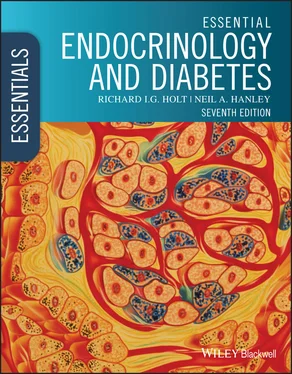1 Cover
2 Title Page
3 Copyright Page
4 Preface
5 List of abbreviations
6 Part 1: Foundations of Endocrinology CHAPTER 1: Overview of endocrinology A brief history of endocrinology and diabetes The role of hormones Classification of hormones Control systems regulating hormone production Endocrine disorders CHAPTER 2: Basic cell biology and hormone synthesis Chromosomes, mitosis and meiosis Synthesizing a peptide or protein hormone Synthesizing a hormone derived from amino acids or cholesterol Hormone transport CHAPTER 3: Molecular basis of hormone action Cell‐surface receptors Nuclear receptors CHAPTER 4: Investigations in endocrinology and diabetes Pre‐analytical requirements for accurate endocrine testing Laboratory assay platforms Reference ranges Static and dynamic testing Cell and molecular biology as diagnostic tools Imaging in endocrinology
7 Part 2: Endocrinology – Biology to Clinical Practice CHAPTER 5: The hypothalamus and pituitary gland Embryology and anatomy Pituitary tumours The hypothalamus The hypothalamic–anterior pituitary hormone axes The anterior pituitary hormones Hypopituitarism Hormones of the posterior pituitary CHAPTER 6: The adrenal gland The adrenal cortex The adrenal medulla CHAPTER 7: Reproductive endocrinology Embryology of the reproductive organs The male reproductive system The female reproductive system Pubertal disorders Subfertility CHAPTER 8: The thyroid gland Embryology Anatomy and vasculature Thyroid hormone biosynthesis Circulating thyroid hormones Function of thyroid hormones Thyroid function tests Clinical disorders CHAPTER 9: Calcium and metabolic bone disorders Calcium Hormones that regulate calcium Clinical disorders of calcium homeostasis Bone health and metabolic bone disease Clinical conditions of bone metabolism Vitamin D deficiency, osteomalacia and rickets CHAPTER 10: Pancreatic and gastrointestinal endocrinology and endocrine neoplasia Pancreatic endocrinology Gastrointestinal endocrinology and associated clinical conditions Endocrine tumour predisposition syndromes Tumours with ectopic hormone production Hormone‐sensitive tumours Other tumours relevant to endocrinology
8 Part 3: Diabetes and Obesity CHAPTER 11: Overview of diabetes A brief history of diabetes and its classification Classification of diabetes Diagnosis of diabetes Insulin Glucagon CHAPTER 12: Type 1 diabetes What is type 1 diabetes? Epidemiology Pathogenesis Aetiology Clinical features Diagnosis Management of type 1 diabetes Acute metabolic emergencies CHAPTER 13: Type 2 diabetes Epidemiology Pathophysiology Prognosis Clinical features Prevention of diabetes Screening for diabetes Management of type 2 diabetes CHAPTER 14: Complications of diabetes Introduction Microvascular complications Pathology of microvascular complications Pathogenesis of microvascular complications Clinical features of microvascular complications Diabetes‐related kidney disease Neuropathy The diabetic foot Genitourinary and sexual problems of diabetes Atherosclerotic cardiovascular disease Heart failure Cancer Non‐alcoholic fatty liver disease Gastro‐intestinal tract Bone and Joint Skin disorders Psychological and psychiatric sequelae of diabetes Diabetes and pregnancy Social sequelae of diabetes Organization of diabetes care CHAPTER 15: Obesity Introduction What is obesity? The health and social consequences of overweight and obesity Regulation of body weight The causes of obesity Genetic factors Environmental changes Prevention of obesity Management of the individual with obesity Conclusions
9 Index
10 End User License Agreement
1 Chapter 1 Table 1.1 Nobel prizewinners in endocrinology and diabetes or those whose dis... Table 1.2 The endocrine organs and their hormones *
2 Chapter 2 Table 2.1 Definition and classification of enzymes
3 Chapter 3 Table 3.1 Use of different G‐protein α‐subunits by various hormone signalling... Table 3.2 Examples of modifications to hormones, their precursors or metaboli... Table 3.3 Defects in nuclear hormone signalling Table 3.4 Examples of important transcription factors required for the develo...
4 Chapter 4 Table 4.1 Endocrine reference ranges
5 Chapter 5 Table 5.1 Summary of anatomy and function of the hypothalamic nuclei Table 5.2 Hormone‐secreting cell types of the anterior pituitary Table 5.3 Cranial nerves in the cavernous sinus Table 5.4 Dynamic tests of growth hormone (GH) statusTable 5.5 Treatments of acromegalyTable 5.6 Investigation and management of diabetes insipidus (DI).
6 Chapter 6Table 6.1 Alternative names in common usage for steroidogenic enzymesTable 6.2 Dexamethasone suppression testsTable 6.3 The effects of catecholaminesTable 6.4 Genes and associated PPGL syndromes
7 Chapter 7Table 7.1 Advantages and disadvantages for different routes of administration...Table 7.2 GynaecomastiaTable 7.3 Different phases of ovarian function and their effectsTable 7.4 Approaching amenorrhoea with absent oestrogenTable 7.5 Approach to amenorrhoea with endogenous oestrogen productionTable 7.6 Treatment of PCOSTable 7.7 Precocious pubertyTable 7.8 An approach to subfertility
8 Chapter 8Table 8.1 Interpretation of thyroid function testsTable 8.2 Symptoms, signs and examination of thyroid eye diseaseTable 8.3 Thyroid malignancy
9 Chapter 9Table 9.1 Comparative actions of vitamin D, parathyroid hormone (PTH) and cal...Table 9.2 Diagnostic criteria for osteoporosis on DEXATable 9.3 Drugs used to prevent bone demineralisation and to treat osteoporos...
10 Chapter 10Table 10.1 Pancreatic and gastrointestinal hormonesTable 10.2 Distribution of carcinoid tumoursTable 10.3 Categories of endocrine tumour predisposition syndromesTable 10.4 Features of multiple endocrine neoplasiaTable 10.5 Examples of ectopic hormone secretion
11 Chapter 11Table 11.1 Prevalence of diabetes in people aged 20–79 years in 2019 and proj...Table 11.2 Genetic mutations in maturity‐onset diabetes of the young (MODY)Table 11.3 The WHO criteria for diagnosing diabetes with plasma glucoseTable 11.4 Factors regulating insulin release from the β‐cells of the pancrea...Table 11.5 Insulin actions on carbohydrate metabolismTable 11.6 Insulin actions on fatty acid metabolism
12 Chapter 12Table 12.1 Islet cell autoantibodies involved in the pathogenesis of type 1 d...Table 12.2 Risk of developing type 1 diabetes for relatives of people with ty...Table 12.3 The main putative environmental triggers of type 1 diabetesTable 12.4 Comparison of presenting features of type 1 diabetes, type 2 diabe...Table 12.5 Pharmacokinetics of meal and basal insulinsTable 12.6 Advantages and disadvantages of twice daily and basal‐bolus regime...Table 12.7 Recommendations for time‐in‐target for people with diabetes using ...Table 12.8 IFCC and DCCT aligned values for HbA 1cTable 12.9 Symptoms and signs of hypoglycaemiaTable 12.10 A management regimen for diabetic ketoacidosis
13 Chapter 13Table 13.1 Why is type 2 diabetes increasing?Table 13.2 Risk factors for type 2 diabetesTable 13.3 Risk of developing type 2 diabetes for relatives of people with ty...Table 13.4 Examples of gene polymorphisms linked with the development of type...Table 13.5 Possible mechanisms of β‐cell decline and dysfunctionTable 13.6 Mortality rates in people with diabetes after adjustment for poten...Table 13.7 Features of commonly used oral antidiabetes agentsTable 13.8 Properties of different sulfonylureasTable 13.9 Properties of different GLP‐1 receptor agonists
14 Chapter 14Table 14.1 Five stages of classical diabetic nephropathyTable 14.2 Do’s and Don’ts of foot careTable 14.3 Features to differentiate acute Charcot from cellulitisTable 14.4 Cancers that occur more frequently in people with diabetes with re...Table 14.5 Psychological and psychiatric conditions that are consequences of,...Table 14.6 Comparison of IADPSG/WHO and NICE diagnostic criteria for gestatio...
Читать дальше












